Norway
Seitenübersicht
[Ausblenden]1 Introduction
Since 1814 Norway is a monarchy which power is divided between the government, the court and the parliament, which is called the Storting[1] . Since October 2013 the government consist of the conservative and the Progress Party and is leaded by Erna Solberg. Since 2013 the government had a few changes. While the Liberal Party and the Christian Democratic Party where added to the government, the Progress Party resigned the government in January 2020 [2] .
Norway belongs together with Sweden and Denmark to Scandinavia. Scandinavia on the other hand belongs together with Finland, Island and some other small Countries to the group of the Nordic countries. Norway has a special position in Europe, they do not belong to the European union, but thanks for being a part in the European economic area (EEA) they take over a lot of laws from the EU. [3]
Many statistics like some surveys of the inhabitants, the democracy index from the Economist [4] or the transparency index [5] shows that Norway has a very strong democracy and also with a lot of trust of its inhabitants.
Norway is also well known for a strong social democratic policy. In the last decades they had mostly a minority government with a social democratic involvement [6] . That could be one reason for a high equality in the society, which is possible to measure by the gini-coefficients, it shows the inequality between the people within a country [7] . The gini-coefficient shows that Norway belongs to one of the countries where the equality, measured by the income, is one of the highest in the world [8] . Also the wage gap between women and men is compared to other OECD countries quite low with 14% in 2018 [9] .
In Norway the currency is the Norwegian Krone, the exchange rate is in July 2020 circa: 1 NOK = 0,1106 USD [10] . In the price comparison of statista, where the purchasing power is measured by the cost of one big mac, only Switzerland is more expensive than Norway [11]
It is not possible to think about Norway, without mention the oil deposits. Norway itself receive the most energy from sustainable sources. But Norway is selling a lot of oil to other countries and the economy has been dependent on oil for a long period in the last century. Not many countries in the world were able to distribute the wealth all over the population like Norway did. [12]
Norway belongs together with Sweden and Denmark to Scandinavia. Scandinavia on the other hand belongs together with Finland, Island and some other small Countries to the group of the Nordic countries. Norway has a special position in Europe, they do not belong to the European union, but thanks for being a part in the European economic area (EEA) they take over a lot of laws from the EU. [3]
Many statistics like some surveys of the inhabitants, the democracy index from the Economist [4] or the transparency index [5] shows that Norway has a very strong democracy and also with a lot of trust of its inhabitants.
Norway is also well known for a strong social democratic policy. In the last decades they had mostly a minority government with a social democratic involvement [6] . That could be one reason for a high equality in the society, which is possible to measure by the gini-coefficients, it shows the inequality between the people within a country [7] . The gini-coefficient shows that Norway belongs to one of the countries where the equality, measured by the income, is one of the highest in the world [8] . Also the wage gap between women and men is compared to other OECD countries quite low with 14% in 2018 [9] .
In Norway the currency is the Norwegian Krone, the exchange rate is in July 2020 circa: 1 NOK = 0,1106 USD [10] . In the price comparison of statista, where the purchasing power is measured by the cost of one big mac, only Switzerland is more expensive than Norway [11]
It is not possible to think about Norway, without mention the oil deposits. Norway itself receive the most energy from sustainable sources. But Norway is selling a lot of oil to other countries and the economy has been dependent on oil for a long period in the last century. Not many countries in the world were able to distribute the wealth all over the population like Norway did. [12]
2 Preparedness
According to Abraham (2011) the attention to the flu in the beginning of the century was an extraordinary development. The fear of a possible Influenza pandemic where the reason for many countries around the world to invent pandemic preparedness plans. It was said by the American president Bush in 2005 that these plans would help to act on the first signal of a threat. [13]
While a good pandemic plan fulfils the wish for certainty in a situation of a Crisis, Ansell and Boin (2017) inserted another way of managing with Crisis. They said it is important that leaders respect the uncertainty, the complexity and the instability of a Crisis. [14]
The pragmatism approach contradicts the approach of a pandemic plan a little. But I think nobody will disagree with me, if I say it is important to have a good health system, with enough resources to supply many people in a case of a health Crisis. I also think it is not a damage to have a pandemic plan.
While a good pandemic plan fulfils the wish for certainty in a situation of a Crisis, Ansell and Boin (2017) inserted another way of managing with Crisis. They said it is important that leaders respect the uncertainty, the complexity and the instability of a Crisis. [14]
The pragmatism approach contradicts the approach of a pandemic plan a little. But I think nobody will disagree with me, if I say it is important to have a good health system, with enough resources to supply many people in a case of a health Crisis. I also think it is not a damage to have a pandemic plan.
2.1 Healthcare System
In 2017 Norway spent 10.3% of its GDP for the health care system, which is better as the OECD- average, which was at 8.7% in 2017 [15] . India and Thailand spent only 2,6% and 3,7% of their GDP. Sweden spent a little more than Norway with 11% of their GDP.
Measured on the GDP, Norway belongs to one of the richest countries in the world 81549 GDP per head [16] . Thanks to this, the total health care expenditures are higher than the proportion of the GDP would suggest.
In Norway there is an insurance fund, which is financed by 75% of contributions and 25% by tax money. Everyone who lives in Norway take profit of this fund. The Citizenship does not matter. But there is still a high deductible, which is covered by nearly 200€ per year. The Fund is not just for the health system, it is also for the pensions, unemployment's benefits and other social issues. [17]
Norway's health care system has two problems. First of all, Norway has a very small population density [18] . So, it is very difficult to ensure a reachability for all citizen. The second problem is, that Norway has not enough study places for medicine. So, they are dependent to doctors from other countries. 15% of the doctors are not from Norway, the most of them come from other countries in Scandinavia [19] .
In the GHS index Norway occupies place 16 [20] . In my opinion does this underlines the strength of the health system in Norway. But also in the GHS index Sweden is a bit better. They are in the seventh place.
Measured on the GDP, Norway belongs to one of the richest countries in the world 81549 GDP per head [16] . Thanks to this, the total health care expenditures are higher than the proportion of the GDP would suggest.
In Norway there is an insurance fund, which is financed by 75% of contributions and 25% by tax money. Everyone who lives in Norway take profit of this fund. The Citizenship does not matter. But there is still a high deductible, which is covered by nearly 200€ per year. The Fund is not just for the health system, it is also for the pensions, unemployment's benefits and other social issues. [17]
Norway's health care system has two problems. First of all, Norway has a very small population density [18] . So, it is very difficult to ensure a reachability for all citizen. The second problem is, that Norway has not enough study places for medicine. So, they are dependent to doctors from other countries. 15% of the doctors are not from Norway, the most of them come from other countries in Scandinavia [19] .
In the GHS index Norway occupies place 16 [20] . In my opinion does this underlines the strength of the health system in Norway. But also in the GHS index Sweden is a bit better. They are in the seventh place.
2.2 Pandemic Preparedness
Like the most other countries in Europe Norway published a pandemic plan in July 2003. It was made for a possible Influenza pandemic. The most important goal of the pandemic plan is to reduce morbidity and mortality. The other objectives are to maintain the essential community services, to nurse all the people and to be able to give all important information to the respective institution or the public. In the pandemic plan the pandemic was divides into 6 phases. The first on is called phase 0 and the definition of it is just that e new virus is somewhere erupted. The next phases include the outbreak in a second country outside Norway, the first cases in Norway and the different waves of the Pandemic. The last phase is the post-pandemic period, when it is the task for the government to get back to normal. An interesting assumption of the pandemic plan is that they do not have the goal to stop the spread of the pandemic, it is their goal to reduce the speed of the pandemic. [21]
Not only Norway invented pandemic plans in respect to a possible Influenza pandemic, also Sweden, Switzerland and Spain where doing this in the beginning of this century.
Beside of the pandemic plan from July 2003, Norway plays a key role in the building up of the coalition for Epidemic Preparedness Innovation (CEPI), which headquarters are in Oslo, the capital city in Norway [22] . CEPI is founded in 2017 to stop future pandemics by developing vaccines [23] . The approach of CEPI is to speed up the development, research and the use of vaccines if a pandemic breaks out. CEPI holds up three steps for a good reaction in a pandemic crisis. First, they want to advance vaccines against known threats and for being prepared for new epidemics they want to establish investigational vaccine stockpiles. The second goal is to develop a platform with the potential to develop a vaccine against unknown pathogens. The third goal is to improve a possibility of a global response in the case of an outbreak of a pandemic [24] . In the end of march, the government announced, that Norway will increase their fund for CEPI by 212 million USD (2 billion NOK) for the next ten years, this should be understood as an response for the corona crisis [25] .
Not only Norway invented pandemic plans in respect to a possible Influenza pandemic, also Sweden, Switzerland and Spain where doing this in the beginning of this century.
Beside of the pandemic plan from July 2003, Norway plays a key role in the building up of the coalition for Epidemic Preparedness Innovation (CEPI), which headquarters are in Oslo, the capital city in Norway [22] . CEPI is founded in 2017 to stop future pandemics by developing vaccines [23] . The approach of CEPI is to speed up the development, research and the use of vaccines if a pandemic breaks out. CEPI holds up three steps for a good reaction in a pandemic crisis. First, they want to advance vaccines against known threats and for being prepared for new epidemics they want to establish investigational vaccine stockpiles. The second goal is to develop a platform with the potential to develop a vaccine against unknown pathogens. The third goal is to improve a possibility of a global response in the case of an outbreak of a pandemic [24] . In the end of march, the government announced, that Norway will increase their fund for CEPI by 212 million USD (2 billion NOK) for the next ten years, this should be understood as an response for the corona crisis [25] .
3 Sense-Making
If we follow Boin et al. (2016) Sense-Making is defined as the collection and processing of information. This should help leaders to evaluate and to detect the crisis. [26]
Countries in which the coronavirus arrived later where in advantage to other countries, because they were able to observe the situation, before it hit themselves very hard. The Norwegian government has been very fast in Reacting after the first cases were released.
Countries in which the coronavirus arrived later where in advantage to other countries, because they were able to observe the situation, before it hit themselves very hard. The Norwegian government has been very fast in Reacting after the first cases were released.
3.1 First Cases
On February 26 the first case was reported. It was a woman who came back from China. She had no symptoms and was told to stay at home for 14 days [27] . In the next days there were more and more cases reported. specially in the south of Norway. On the second march there were 43 cases reported and it looked more and more like the health system cannot track all the cases anymore [28] .
On the 12th march the first death was reported [29] . On this day, the government announced the most important measures, they closed the schools, universities and kindergartens [30] [31] .
On the 12th march the first death was reported [29] . On this day, the government announced the most important measures, they closed the schools, universities and kindergartens [30] [31] .
3.2 Development of pandemic infections
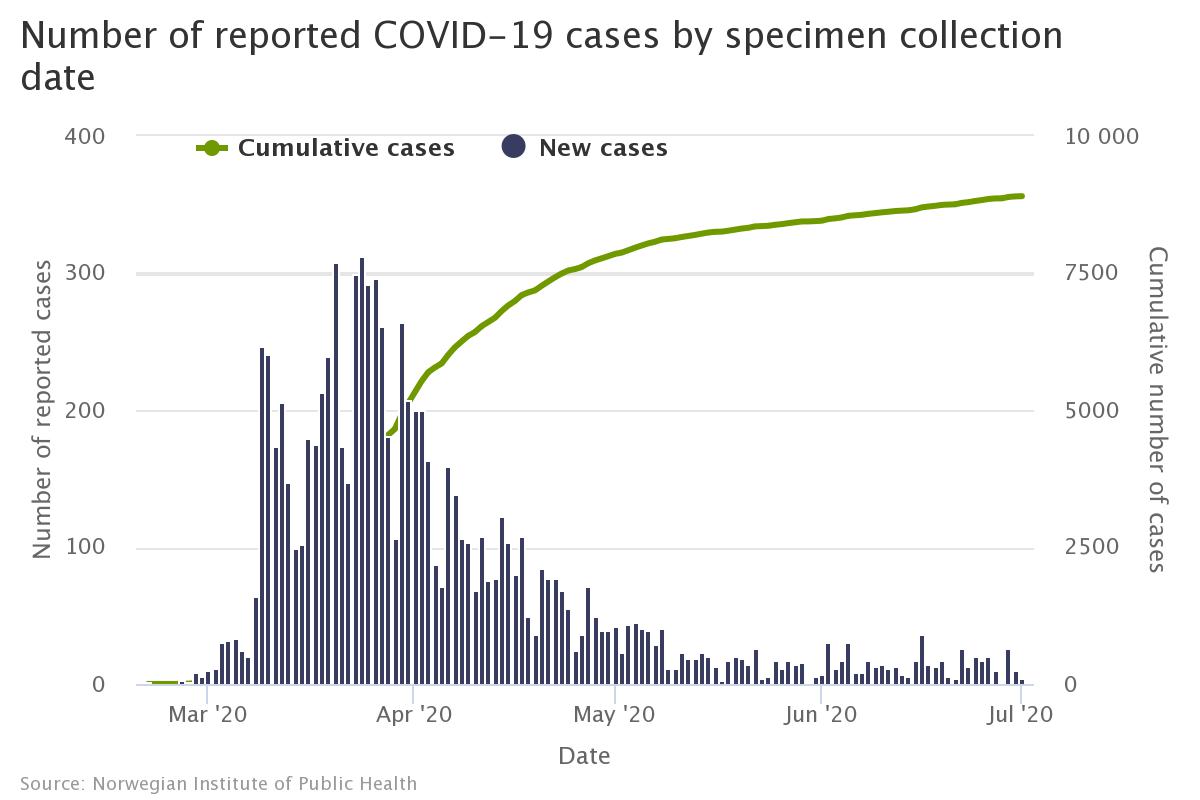
https://www.fhi.no/en/id/infectious-diseases/coronavirus/daily-reports/daily-reports-COVID19/, accessed on 2.7.2020
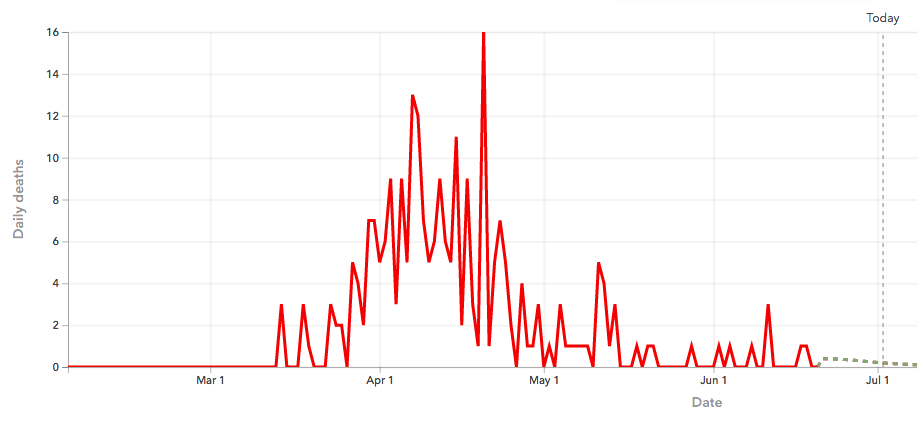
https://covid19.healthdata.org/norway, accessed on 4.7.2020
In the beginning of the corona-pandemic there was a fast rise of the infections. The rise of the deaths was a bit later. In the statistic of the infections you can see that the biggest rise has happened in the end of march, when the most measures were already active for 2 or 3 weeks. These early interventions could be one reason for the success of Norway to keep the numbers of the infections and the death rate quite low in the end. The day with the most deaths was the 24th of April when 16 people died after an infection with the coronavirus. After that it was possible to observe a rapidly decline of the deaths and the infections. [32]
3.3 Testing and reporting logic
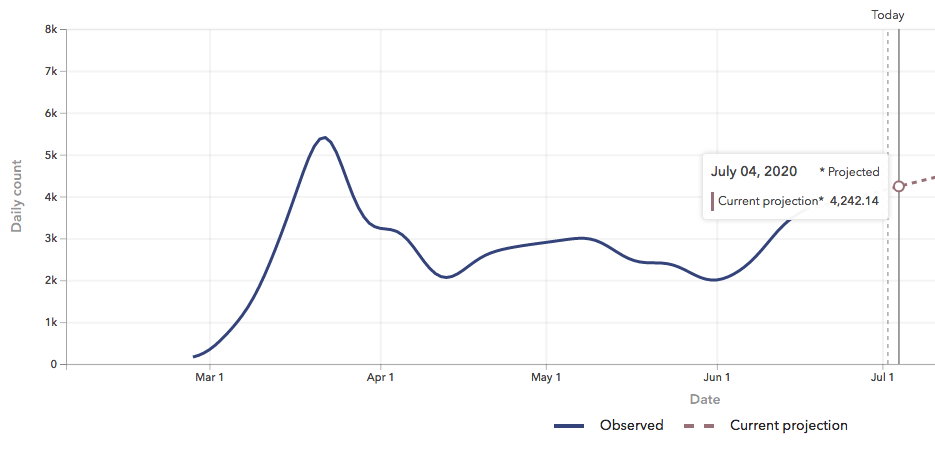
https://covid19.healthdata.org/norway, accessed on 4.7.2020
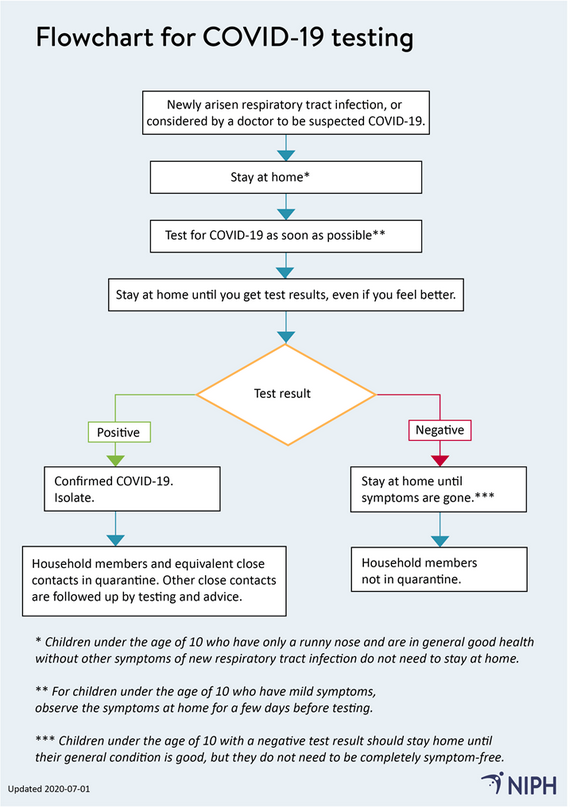
https://www.fhi.no/en/op/novel-coronavirus-facts-advice/testing-and-follow-up/test-criteria-for-coronavirus/, accessed on 13.7.2020
In the statistic above you can see the number of tests which were made since the end of February. Although not everyone was allowed to be tested in the beginning of the pandemic the number of tests had a strong increase in the beginning. When the number of coronavirus infections and the number of tests per day decreased a bit, the government relaxed the criteria's for a corona test. They announced on April 1 that everyone with respiratory tract infections or other symptoms which might caused by COVID-19 are allowed to be tested. To be sure, that the right people are tested the government developed a priority paper, with this the doctors should decide who is being tested, if there is a lack of testing capacity. But if the capacity allows it, also people with mild symptoms were allowed to be tested from this moment, this could explain the rise of the testing numbers since June, although the number of coronavirus infections are still decreasing. The government also announced on the first April that it could be sensible to test people without any symptoms, for example, if new residents move into a nursing home. [33]
The flowchart on the right shows the testing logic. It does not show some really special things, but you can see which people have to go to quarantine and what happens when the coronavirus test is negative.
The flowchart on the right shows the testing logic. It does not show some really special things, but you can see which people have to go to quarantine and what happens when the coronavirus test is negative.
4 Decision-Making
If we follow Boin et al. (2016) Decision-Making is Coordinating and is defined as making in strategic dilemmas critical calls [34] .
There are a few ways to respond on a Crisis. First it is in different ways possible to not decide. Secondly it is possible to decentralize the decisions, so the government can shift the responsibility to the local level. The third way to respond in a crisis is to improvise, Boin et al. (2016) are saying that crisis have the ability to make the best plans irrelevant. [35]
The Norwegian government were making their decisions in a central system, they were also inventing an emergency law, which makes clear the willingness of a fast and effective reaction.
There are a few ways to respond on a Crisis. First it is in different ways possible to not decide. Secondly it is possible to decentralize the decisions, so the government can shift the responsibility to the local level. The third way to respond in a crisis is to improvise, Boin et al. (2016) are saying that crisis have the ability to make the best plans irrelevant. [35]
The Norwegian government were making their decisions in a central system, they were also inventing an emergency law, which makes clear the willingness of a fast and effective reaction.
4.1 Social Distancing rules
On March 12, the day when the first death was announced, the prime minister Erna Solberg decided to close the schools, the kindergartens and the universities. The government also forbid all events with more than 50 people. [36]
Norway where inventing their measurements not much earlier than other countries. It is not too easy to compare these data, because all countries had different infection events. Some are comparing the days after the first case was reported, but in my opinion also this data is not very objective. It is striking that the most European countries like Bulgaria, France, Spain, Netherlands and Switzerland were implementing their first important measurements from March 12 to March 16.
On March 15 the government decided to impose an entry ban for people without a residence release, that arrangement did also count for people from Schengen and other European countries. But the airports remained open. [37]
The first step back to a new normality was the opening of the primary schools and Kindergartens on April 27 [38] . In the weeks after that other institutions like the other schools, the bars, the restaurants, cultural and sport events with less than 200 people were allowed to reopen again [39] .
Since July 15 the borders are open again for the most European regions [40] .
Norway where inventing their measurements not much earlier than other countries. It is not too easy to compare these data, because all countries had different infection events. Some are comparing the days after the first case was reported, but in my opinion also this data is not very objective. It is striking that the most European countries like Bulgaria, France, Spain, Netherlands and Switzerland were implementing their first important measurements from March 12 to March 16.
On March 15 the government decided to impose an entry ban for people without a residence release, that arrangement did also count for people from Schengen and other European countries. But the airports remained open. [37]
The first step back to a new normality was the opening of the primary schools and Kindergartens on April 27 [38] . In the weeks after that other institutions like the other schools, the bars, the restaurants, cultural and sport events with less than 200 people were allowed to reopen again [39] .
Since July 15 the borders are open again for the most European regions [40] .
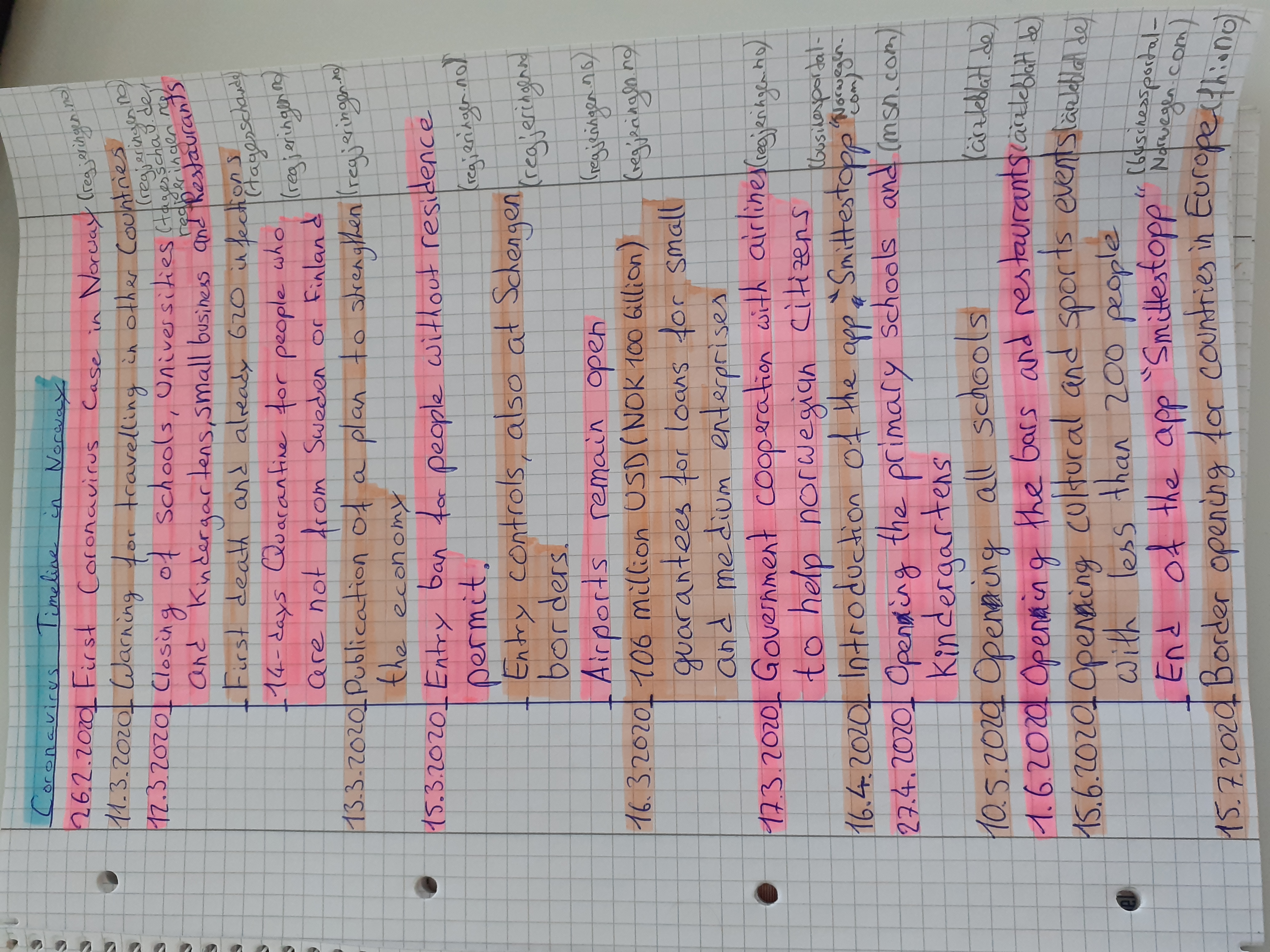
4.2 Emergency Law
The government around Erna Solberg developed a law, which would make it possible to decide without the approval from the parliament, to make their decision faster and more efficient in the high phase of the coronavirus pandemic. The government argued that this law would be necessarily to ensure the functioning of the society. [41]
Also other states like Switzerland and Thailand implemented an emergency law. In Thailand had the prime minister because of that a special authority. In Norway it was not mention that the prime Erna Solberg had any extra power, but what makes the Norwegian case very special is the fact that the government does not have a majority in the parliament [42]
The Opposition in Norway criticized it for giving the government to much power for a long time. On the 21st march they passed a modified law, which was valid for just one month. Later it was extended until the 27th of May [43] . 32 Laws were confirmed with this emergency law [44] .
Also other states like Switzerland and Thailand implemented an emergency law. In Thailand had the prime minister because of that a special authority. In Norway it was not mention that the prime Erna Solberg had any extra power, but what makes the Norwegian case very special is the fact that the government does not have a majority in the parliament [42]
The Opposition in Norway criticized it for giving the government to much power for a long time. On the 21st march they passed a modified law, which was valid for just one month. Later it was extended until the 27th of May [43] . 32 Laws were confirmed with this emergency law [44] .
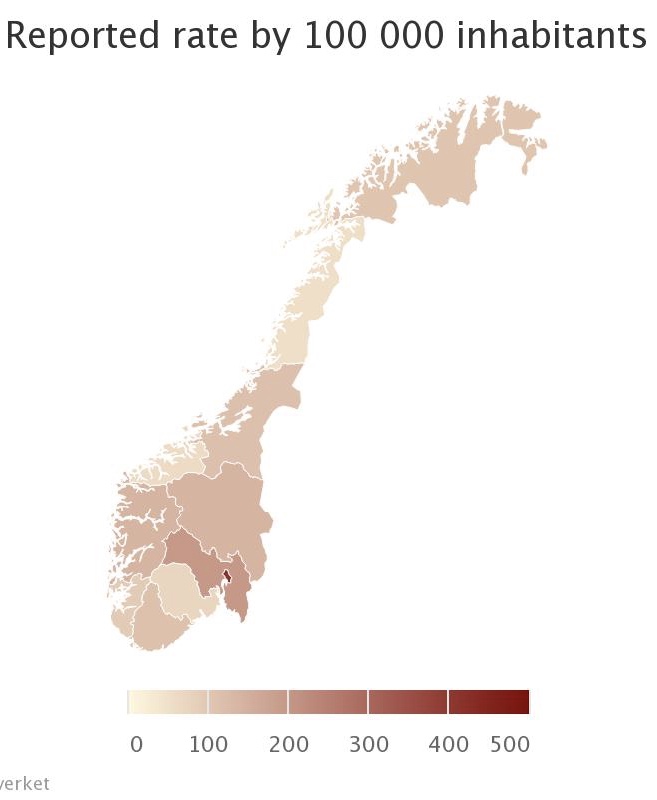
https://www.fhi.no/en/id/infectious-diseases/coronavirus/daily-reports/daily-reports-COVID19/, accessed on 4.7.2020
4.3 Unequal distribution of the infections
The regions in Norway were not hit with the same strength with the coronavirus. Some regions like Oslo and the regions around Oslo had much more cases than others. Specially the north in Norway was mostly spared. There are still some regions without even one corona cases. There might be many reasons for this unequal distribution of the coronavirus case. One of them is the fact, that in the north of Norway live significantly fewer people per square kilometre and the people in these regions had to be more afraid, because of a lack of medical supplies in a case of a pandemic. [45]
Norway has not been the only country with an uneven distribution of the infections, also India had to handle an uneven distribution of the infections.
Norway has not been the only country with an uneven distribution of the infections, also India had to handle an uneven distribution of the infections.
4.4 App Smittestopp
The government of Norway had the target to develope an app very fast. It should help the health offices to track the chains of infections [46] . The App was released on the 16th April, which was quite early, compared to other European countries. But the app was also criticized by many people, because there were only 620.000 who used it after a month and it did not fulfil the standards of privacy [47] . While the Corona-app from India is online and open for review, the data was centralized and not an open-source program in the Norwegian App. After nearly 2 months, on June 12 a data protection authority forbid the Corona-app, because of the proportionality between the data protection and the lack of treat of the pandemic at this moment [48] . The usefulness of the corona-app was never clear, because of too few users [49] .It is important to differentiate between the kind of apps. Some countries like Netherlands where able to create an app, but only to inform the population and not for contact-tracing. Other countries like Switzerland, India, Taiwan and South Korea were inventing an app with a contact-tracing function.
4.5 Effect on the economy
Not only the number of death and the number of infected persons is important for the well-being of the Population. Another factor is the strength of the economy, which defines the possibility for the people to have a good life. The unemployment figures were exploding in the beginning of the crisis. Within a few weeks the number of unemployment's rose from 2% to 10%. In the beginning the government assumed a go down of the private economy by 15% to 20%. [50]
All this happened before March 24. Already before these horror numbers were released, the government decided to implement laws to help the population and the economy. They proposed two new loan measures which would help companies specially in terms of liquidity. [51]
It was also possible as an Norwegian inhabitant to put off some tax rates and the universities and schools were supported with extra money [52] .
Like some other countries the government paid short-time allowance to safe jobs. In norway the conditions of the short-time allowance was one of the best in Europe while the coronavirus pandemic [53] . Norway belonged to one of the countries where the short-time allowance covered 100% of the normal salary[54] .
In spite of the help of the government for the people and the companies, the effect on the economy is high. But if we take a look to Sweden, the neighbouring country of Norway, which did not invent hard measurements like school closures, we can see, that a lower restriction would not help that much, because also Sweden has slipped into a deep economic crisis.
All this happened before March 24. Already before these horror numbers were released, the government decided to implement laws to help the population and the economy. They proposed two new loan measures which would help companies specially in terms of liquidity. [51]
It was also possible as an Norwegian inhabitant to put off some tax rates and the universities and schools were supported with extra money [52] .
Like some other countries the government paid short-time allowance to safe jobs. In norway the conditions of the short-time allowance was one of the best in Europe while the coronavirus pandemic [53] . Norway belonged to one of the countries where the short-time allowance covered 100% of the normal salary[54] .
In spite of the help of the government for the people and the companies, the effect on the economy is high. But if we take a look to Sweden, the neighbouring country of Norway, which did not invent hard measurements like school closures, we can see, that a lower restriction would not help that much, because also Sweden has slipped into a deep economic crisis.
5 Legitimacy
If we follow Christensen et al. (2019) legitimacy is defined as the relationship between the government and the population. For the degree of legitimacy, the perception of the inhabitants about the actions are important. [55]
5.1 Severity of government restrictions
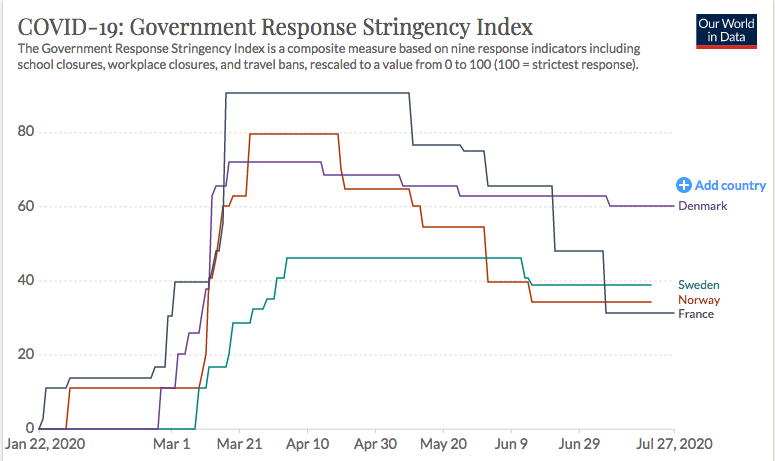
https://www.bsg.ox.ac.uk/research/research-projects/coronavirus-government-response-tracker, accessed on 29.7.2020
Norway never implemented a total lockdown or very strong measurements in the coronavirus crisis. The hardest and most important restriction was the closure of schools, universities, small business and restaurants. They have been able to keep the infection rate after the first wave at a low level, also without very strong measurements.
You can also see in the Covid-19: government response stringency index that Norway invented lower measurements than other countries like France and Denmark. But also Spain, Thailand and India were implementing much stricter rules than Norway. But Norway took the threat of the coronavirus with a high level of urgency, unlike other countries, like Brazil or Sweden, the latter country is seen from many people as a role model for very unrestricted rules without losing control over the infections. Also Switzerland, Taiwan and Netherlands invented much lower measurements than Norway.
You can also see in the Covid-19: government response stringency index that Norway invented lower measurements than other countries like France and Denmark. But also Spain, Thailand and India were implementing much stricter rules than Norway. But Norway took the threat of the coronavirus with a high level of urgency, unlike other countries, like Brazil or Sweden, the latter country is seen from many people as a role model for very unrestricted rules without losing control over the infections. Also Switzerland, Taiwan and Netherlands invented much lower measurements than Norway.
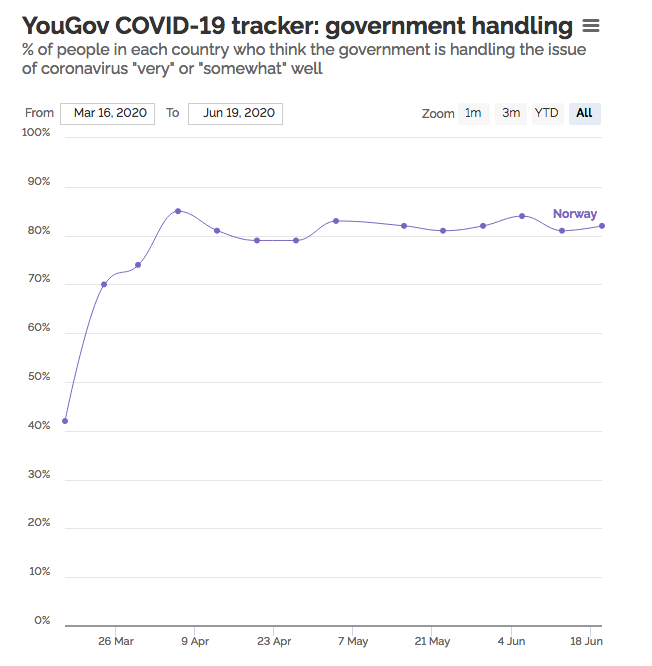
5.2 Confidence in government and health authorities
Traditionally the trust from the inhabitants of Norway in their government is quite high [56] . The more surprisingly it is, that in the beginning of the corona-crisis the people were not that happy with the handling of the coronavirus. But you can see in the statistic above that the satisfaction with the government increased very fast. The curve which explains the confidence in health authorities is quite similar. The difference is, that the confidence was in the beginning of the crisis higher for the health authorities than for the government [57] .
In the countries in our wikis, the happiness with the government varies throughout the nations. There are countries like Netherlands, Switzerland and Bulgaria where the people are very happy with the handling of the government with the coronavirus and there are other countries like Thailand and France where the people are not that happy. Also the satisfying of the people from Sweden is much lower than in Norway.
In the countries in our wikis, the happiness with the government varies throughout the nations. There are countries like Netherlands, Switzerland and Bulgaria where the people are very happy with the handling of the government with the coronavirus and there are other countries like Thailand and France where the people are not that happy. Also the satisfying of the people from Sweden is much lower than in Norway.
5.3 State of democracy and internal social relationships
SGI Bertelsmann-Stiftung | Freedom-House-Index | Economist Democracy Measurement | Democracy Barometer | Corruption | ||
Status Index | Management Index | |||||
Last updated 2011 (rankings in brackets) | Last updated 2012 | Last updated 2012 (Rankings in the brackets) | Last updated 2005 (Rankings) | Last updated 2012 (Rankings in the brackets | ||
Norway | 8,64 (2) | 8,20 (2) | Free | 9,93 (1) | 6 | 85 (7) |
"N" of the studies | 31 | 31 | 195 (and 14 territories) | 167 | 30 | 174 |
Norway belongs to one of the strongest democracies in the world. In every statistic which tries to measure the strength of the democracy it is on the top of the list. In the most statistics the only country who can beat Norway are other Scandinavian or Nordic countries.
Not only the democracy of Norway is very strong, Norway is also well known for the equality of the society. Some studies show that countries with an equal society are happier and healthier (positive for the coronavirus development) than others. [58]
Not only the democracy of Norway is very strong, Norway is also well known for the equality of the society. Some studies show that countries with an equal society are happier and healthier (positive for the coronavirus development) than others. [58]
6 Overall Evaluation
How do we evaluate the achievement of a country in a situation like the coronavirus pandemic? It would be possible to just look at the numbers of infections and deaths. But that would be thought too short in my opinion. There are many other factors which are important to consider. I will focus on the key points, I had already reported about.
6.1 Preparedness
If it is possible to be well prepared for a situation like the coronavirus pandemic, Norway has been very good prepared. They had a solid expenditure for the healthcare system. A general problem of the Norwegian healthcare system is the small population density, which leads to difficulties in the supply of the people in the countryside.
Besides a generally strong healthcare system, Norway belongs to one of the countries with a pandemic plan. The amount of benefit of that is not very clear, but I think it can also helps the government to structure a situation of crisis. I think what is more interesting and positive in and case like the coronavirus is the Norwegian engagement in the CEPI, because they could play a key role in the developing of a vaccine.
Besides a generally strong healthcare system, Norway belongs to one of the countries with a pandemic plan. The amount of benefit of that is not very clear, but I think it can also helps the government to structure a situation of crisis. I think what is more interesting and positive in and case like the coronavirus is the Norwegian engagement in the CEPI, because they could play a key role in the developing of a vaccine.
6.2 Sense-Making
The Norwegian government has been always very transparent with information and they were always observing the actual infection situation. This led to it, that Norway has been always able to implement a fast reaction for the actual situation. The transparency with the information might be also one reason for the satisfaction of the population with the government.
In the beginning of the pandemic the healthcare system had struggle to come along with the infection events and the number of tests. But after a while they have been able to test more and more people to get a good overview about the number of infections. In my opinion it is also a good idea to test people randomly, also without any symptoms, just to know If there is a local outbreak.
In the beginning of the pandemic the healthcare system had struggle to come along with the infection events and the number of tests. But after a while they have been able to test more and more people to get a good overview about the number of infections. In my opinion it is also a good idea to test people randomly, also without any symptoms, just to know If there is a local outbreak.
6.3 Decision-Making
In Europe Norway was one of the first countries who implemented restriction rules and in my opinion, they found a good way between safety and protection in case of the coronavirus and to not restrict the freedom too much. These early restrictions might have been the reason, why Norway where able to achieve their goal in the pandemic plan to slow down the infections.
The Norwegian government were not only looking to keep the infection rate low. They were also making an effort to keep the economic impact for the people on a low level. Which was possible with a loan for the companies and with help like the short-time allowance and others to safe many people from poverty.
Not everything went fine in Norway while the coronavirus pandemic. Norway where able to develop a coronavirus Tracing App very fast, compared to Switzerland and also Netherlands. The latter one even failed to develop a tracing app. Maybe Norway where faster than other countries, but that does not been they have been more successful. While the app was very early available it was deleted again in the middle of June, because of a lack of data protection.
The Norwegian government were not only looking to keep the infection rate low. They were also making an effort to keep the economic impact for the people on a low level. Which was possible with a loan for the companies and with help like the short-time allowance and others to safe many people from poverty.
Not everything went fine in Norway while the coronavirus pandemic. Norway where able to develop a coronavirus Tracing App very fast, compared to Switzerland and also Netherlands. The latter one even failed to develop a tracing app. Maybe Norway where faster than other countries, but that does not been they have been more successful. While the app was very early available it was deleted again in the middle of June, because of a lack of data protection.
6.4 Legitimacy
Normally, in a situation without any coronavirus crisis, Norway belongs to one of the strongest democracies in the world. The statistic which measures democracy, where Norway is not to be found on the top of the list has to be founded first.
Norway implemented an emergency law, which has to be seen in a special way, because the actual government does not have a majority in the parliament. In the time when this emergency law was in charge, they implemented 32 laws. This emergency law was not only criticized by the opposition. Even the accusation of a coup d’état was voiced. But after a shortening of the length of the emergency law, the parliament agreed to implement this law and I would say that this emergency law has to be seen very critical and with attention, but in a crisis like the coronavirus crisis it might make sense to implement such kind of law.
It is interesting that the Norwegian population has not been very satisfied with their government in the beginning of the pandemic, because normally the satisfaction with the government is in Norway very high. But I think the Norwegian government were able to earn the trust of their population with good and effective work back.
Norway implemented an emergency law, which has to be seen in a special way, because the actual government does not have a majority in the parliament. In the time when this emergency law was in charge, they implemented 32 laws. This emergency law was not only criticized by the opposition. Even the accusation of a coup d’état was voiced. But after a shortening of the length of the emergency law, the parliament agreed to implement this law and I would say that this emergency law has to be seen very critical and with attention, but in a crisis like the coronavirus crisis it might make sense to implement such kind of law.
It is interesting that the Norwegian population has not been very satisfied with their government in the beginning of the pandemic, because normally the satisfaction with the government is in Norway very high. But I think the Norwegian government were able to earn the trust of their population with good and effective work back.
7 Favourite stay at home song
If you follow the website acharts.co the song Karantene from TIX was the one which was heard by the most people from march 31 to April 21, that is the time when the most people had to stay much time at home, because of closed schools, Kindergartens and other closed institutions [59] .
But I also want to introduce you the Remix which is called Ooops!, it is quite funny and got viral in Norway.
But I also want to introduce you the Remix which is called Ooops!, it is quite funny and got viral in Norway.
[1] https://www.regjeringen.no/en/the-government/the-government-at-work1/id85844/, accessed on 2.7.2020
[2] https://www.regjeringen.no/en/the-government/solberg/id85843/, accessed on 2.7.2020
[3] Grøn, C. H., Wivel, A., (2018). Scandinavia and the European Union: Pragmatic functionalism reconsidered. Routledge, 269-280
[4] https://www.eiu.com/topic/democracy-index, accessed on 29.6.2020
[5] https://www.transparency.org/en/cpi/2019/results/nld, accessed on 29.6.2020
[6] http://www.parlgov.org/explore/nor/election/, accessed on 29.6.2020
[7] https://www.lai.fu-berlin.de/e-learning/projekte/vwl_basiswissen/Umverteilung/Gini_Koeffizient/index.html, accessed on 12.7.2020
[8] https://knoema.de/atlas/ranks/Gini-Koeffizient?baseRegion=NO, accessed on 12.7.2020
[9] https://ec.europa.eu/eurostat/tgm/table.do?tab=table&init=1&language=en&pcode=sdg_05_20&plugin=1, accessed on 29.6.2020
[10] https://www.xe.com/currencyconverter/convert/?From=NOK&To=USD, accessed on 22.7.2020
[11] https://de.statista.com/statistik/daten/studie/199335/umfrage/big-mac-index--weltweiter-preis-fuer-einen-big-mac/, accessed on 15.7.2020
[12] https://www.sueddeutsche.de/wirtschaft/norwegen-erdoel-johan-sverdrup-1.4747060, accessed on 29.7.2020
[13] Abraham, T. (2011). The cronicle of a disease foretold: Pandemic H1N1 and the construction of a global health security threat. Political Studies, London: Political SAGE Studies, 59(4), 797-812
[14] Ansell, C., Boin, A. (2017). Taming deep uncertainty: The potential of pragmatist principles for UNderstanding and iimproving strategic crisis management. Administration and society, Los Angeles: SAGE Publications, 51(7), 1079-1112
[15] https://stats.oecd.org/Index.aspx?DataSetCode=SHA#, accessed on 12.7.2020
[16] https://de.statista.com/statistik/daten/studie/166224/umfrage/ranking-der-20-laender-mit-dem-groessten-bruttoinlandsprodukt-pro-kopf/, accessed on 3.7.2020
[17] https://gesundheitsseiten.de/start.php?nas=l,0350,0250, accessed on 30.6.2020
[18] https://www.norwegenservice.net/das-norwegische-gesundheitssystem, accessed on 30.6.2020
[19] https://gesundheitsseiten.de/start.php?nas=l,0350,0250, accessed on 30.6.2020
[20] https://www.ghsindex.org/, accessed on 29.7.2020
[21] http://www.fao.org/docs/eims/upload/221484/national_plan_ai_nor_en.pdf, accessed on 2.7.2020
[22] https://www.regjeringen.no/en/aktuelt/norways-health-related-measures-during-the-covid-19-pandemic/id2695470/, accessed on 13.7.2020
[23] https://cepi.net/, accessed on 15.7.2020
[24] https://cepi.net/about/whyweexist/, accessed on 13.7.2020
[25] https://www.regjeringen.no/en/aktuelt/norways-health-related-measures-during-the-covid-19-pandemic/id2695470/, accessed on 15.7.2020
[26] Boin, A., t'Hart, P., Stern, E., Sundelius, B. (2016). Managing Cirises: Five strategic Leadership tasks. 3-22
[27] https://www.heise.de/tp/features/Skandinavien-und-Corona-Faelle-Zwischen-Klartext-und-Verdraengung-4670848.html, accessed on 3.7.2020
[28] https://www.fhi.no/en/id/infectious-diseases/coronavirus/daily-reports/daily-reports-COVID19/, accessed on 13.7.2020
[29] https://www.nrk.no/norge/forste-koronadodsfall-i-norge-1.14941788, accessed on 3.7.2020
[30] https://www.regjeringen.no/en/aktuelt/coronavirus-measures-to-continue/id2694682/, accessed on 13.7.2020
[31] https://www.tagesschau.de/newsticker/liveblog-coronavirus-109.html#Ministerpraesidenten-beraten, accessed on 13.7.2020
[32] https://covid19.healthdata.org/norway, accessed on 4.7.2020
[33] https://www.fhi.no/en/op/novel-coronavirus-facts-advice/testing-and-follow-up/test-criteria-for-coronavirus/, accessed on 13.7.2020
[34] Boin, A., t'Hart, P., Stern, E., Sundelius, B. (2016). Managing Cirises: Five strategic Leadership tasks. 3-22
[35] Boin, A., t'Hart, P., Stern, E., Sundelius, B. (2016). Decision Making and Coordinating: Shaping the crisis response. 49-77
[36] https://www.regjeringen.no/en/aktuelt/coronavirus-measures-to-continue/id2694682/, accessed on 13.7.2020
[37] https://www.regjeringen.no/en/aktuelt/stricter-border-controls-being-introduced/id2693624/, accessed on 13.7.2020
[38] https://www.msn.com/de-de/nachrichten/video/norwegen-streitet-waren-schulschlie%C3%9Fungen-sinnlos/vi-BB13Zjtf, accessed on 13.7.2020
[39] https://www.aerzteblatt.de/nachrichten/112702/Norwegen-beschleunigt-Lockerung-der-Massnahmen, accessed on 13.7.2020
[40] https://www.fhi.no/en/news/2020/grenseapning-i-forbindelse-med-covid-19/, accessed on 13.7.2020
[41] https://www.sueddeutsche.de/politik/kampf-gegen-das-virus-von-kleinen-helden-und-grossen-zahlen-1.4851474, accessed on 13.7.2020
[42] http://www.parlgov.org/explore/nor/cabinet/2020-01-24/, accessed on 29.7.2020
[43] https://taz.de/Corona-Gesetz-in-Norwegen/!5673129/, accessed on 13.7.2020
[44] https://www.stortinget.no/no/Hva-skjer-pa-Stortinget/Nyhetsarkiv/Hva-skjer-nyheter/2019-2020/koronaloven-opphevet/, accessed on 13.7.2020
[45] https://www.auswaertiges-amt.de/de/aussenpolitik/laender/norwegen-node/norwegensicherheit/205878#content_4, accessed on 13.7.2020
[46] https://handelskammer.blog/norwegische-tracing-app-seit-april-im-einsatz/, accessed on 30.6.2020
[47] https://businessportal-norwegen.com/2020/06/18/corona-app-in-norwegen-wegen-mangelnden-datenschutzes-gestoppt/, accessed on 13.7.2020
[48] https://businessportal-norwegen.com/2020/06/18/corona-app-in-norwegen-wegen-mangelnden-datenschutzes-gestoppt/, accessed on 13.7.2020
[49] https://businessportal-norwegen.com/2020/06/18/corona-app-in-norwegen-wegen-mangelnden-datenschutzes-gestoppt/, accessed on 13.7.2020
[50] https://de.reuters.com/article/norwegen-arbeitsmarkt-virus-idDEKBN21B22W, accessed on 29.7.2020
[51] https://www.regjeringen.no/en/aktuelt/nok-100-billion-worth-of-guarantees-and-loans-in-crisis-support-for-businesses/id2693668/, accessed on 29.7.2020
[52] https://www.gtai.de/gtai-de/trade/specials/special/norwegen/norwegen-wagt-die-stufenweise-lockerung-der-coronamassnahmen-236494, accessed on 29.7.2020
[53] https://handelskammer.blog/kurzarbeit-in-norwegen/, accessed on 29.7.2020
[54] https://www.sueddeutsche.de/karriere/arbeitsmarkt-deutschland-ist-schlusslicht-bei-hoehe-des-kurzarbeitergelds-dpa.urn-newsml-dpa-com-20090101-200401-99-551936, accessed on 14.7.2020
[55] Christensen, T., Laergreid, P., Rykkja, L. H. (2019). Organizing for Societal Security and Crisis Management: Governance Capacity and Legitimacy. Societal Security and Crisis Management, Springer, 1-23
[56] Jochem, S. (2014). Skandinavien. Bibliothek der Universität Konstanz
[57] https://yougov.co.uk/topics/international/articles-reports/2020/03/17/perception-government-handling-covid-19, accessed on 1.7.2020
[58] Jensen, C., Van Kersbergen, K,, (2017) The Politics of Inequality. London, New York: Macmilian Education, Palgrave
[59] https://acharts.co/norway_singles_top_20/2020/16, accessed on 14.7.2020